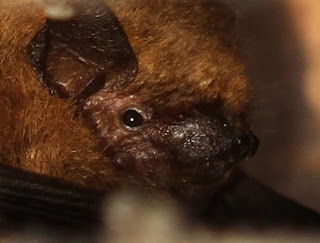This morning had a decidedly spring feel about it as I ventured out for an early morning walk; the sun was slowly rising on a partly clouded sky, there was a crisp spring feel to the air and a Common Chiffchaff was singing from a nearby copse. I had decided to start with a cliff walk, before heading down to Valency Valley in search of Dippers. A brisk northerly wind was blowing, which was being used to its full by the resident Fulmars, as they searched the cliffs for nesting places. Many of the best ledges had already been taken, and paired up birds were settled and delicately preening each other, or uttering their raucous call whilst others passed close by.
 |
| Northern Fulmar |
Driven on by the cold wind, I headed down into the village of Boscastle and onto Valency Valley, and some shelter. I saw my first Dipper in the village centre, unfortunately though, it saw me first and flew down stream and out of view. I continued upstream keeping an eye out for any movement, but initially, other than a Robin and a Wren, both pretending to be Dippers, I was out of luck. The valley was starting to show signs of spring, with the first Bluebells, Wood Sorrel, Opposite-leaved Golden-saxifrage and Red Campion in bloom.
 |
| Valency River |
The river was flowing well, which was making it difficult for me to hear anything else, but one species that was evident was the Common Chiffchaff. Given the number I was hearing in the valley, at least 10, I am assuming these were migrant birds, and not wintering individuals that have started to sing. I continued up the valley, and in the distance noticed the familiar white breast of a Dipper. The bird was on a rock in the location where I found a nest last year, so I quietly sneaked up to a closer view point.
 |
| Dipper |
As I crept into position the bird saw me and flew downstream, so I found some suitable cover behind a gorse bush and settled down for the wait. My patience paid off, as within 30 minutes a second bird dropped out of the presumed nest site, sat on a rock in front of me, and began to preen. The way this bird was behaving, constantly preening and stretching, I am assuming it was currently incubating eggs...but I didn't check the nest to confirm that.
 |
| Dipper |
For around 15 minutes this bird sat preening before being joined by the second bird, presumably the male. He kept his distance, whilst the female preened, although at one point the two birds briefly came together, before the male was chased off.
 |
| Pair of Dippers |
The female then flew to the bank and rummaged along the waters edge for a while, before collecting a small piece of nesting material and heading back to the nest. Both birds were seemingly totally oblivious or unperturbed by my presence, and the male continued to feed along the waters edge, before eventually flying back downstream.
 |
| Dipper with Nest Material |
Whenever I see Dippers, and other birds with pure white feathers for that matter, I am amazed at how they manage to keep them so clean. Dippers live in a wet and muddy environment and yet they always look so immaculate, they must spend so much time cleaning.
 |
| Blue Tit by Nest Hole |
I continued on up the valley, crossing the river and heading up to Minster Church, before noticing a split in a tree that looked good for bats. Whilst scanning for droppings, a female Blue Tit flew into the hole carrying nesting material, whilst the male waited outside calling. When I first started bird ringing, all of the Blue Tits in my nest boxes used to fledge around the third week of May, these days however chicks fledge anytime between late April and early June! All down to climate change, and the odd weather we have these days apparently.



















































